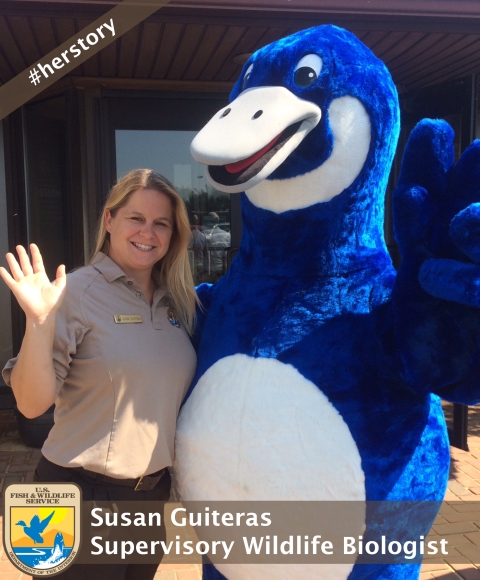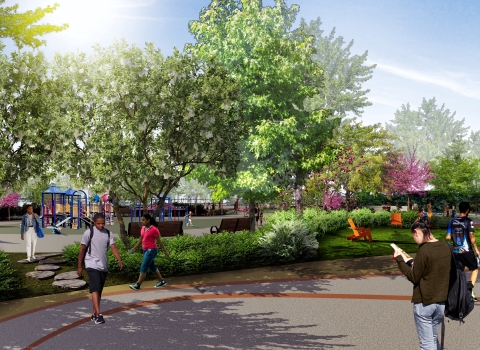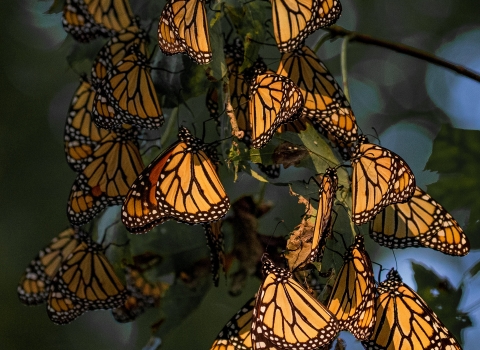The ebbs and flows of Susan Guiteras’ life—professional and personal—have always been in sync with the tides of the environment she works in. She's been working on the shores of Delaware, at Bombay Hook National Wildlife Refuge and Prime Hook National Wildlife Refuge, since 2002 and has been the supervisory wildlife biologist of the refuges since 2007. Guiteras is one of the longest-tenured staffers at the Delaware refuge, and she remembers the story of Hurricane Sandy inside and out.
For her, it’s a story that begins well before Sandy even struck: It starts in 2006 when Prime Hook National Wildlife Refuge saw its first big storm—the first of more to come.
“That was mother nature making herself known,” Guiteras said. The storm was the first tap on the shoulder, pushing refuge managers’ growing suspicion that the refuge’s management conflicted with the natural course of the coastal ecosystem.
Situated on the Delaware shore, the refuge once managed 4,000 acres of artificial freshwater impoundments. Water control devices kept out tidal influence out of what would be salt marsh salt marsh
Salt marshes are found in tidal areas near the coast, where freshwater mixes with saltwater.
Learn more about salt marsh if tides were left to their own devices. The resulting freshwater marsh provided habitat for freshwater ducks and game fowl and plenty of space for recreational hunters.
In 2008, another storm hit, this time breaking one of the impoundments and ushering salt water into the fresh. Even still managers were able to restore the original freshwater impoundments.
In 2009, Guiteras had just had her first child when two back-to-back nor ‘easters hit. She was on maternity leave at the time watching storm updates from home “with a baby on my shoulder literally,” she said. Those signaled the “point of no return” to Guiteras.
The freshwater impoundments had to go.
“The system was really trying to return,” she said. “At first it was mother nature tapping us on the shoulder saying ‘psst, we have a problem.’ Eventually she shook us by the shoulders screaming ‘HELLO!’”
Thus began a long process of planning and modeling to figure out how to healthily restore tidal flow at the refuge.
In 2012, all these efforts to overhaul the impoundments were already in motion. Guiteras was again out on maternity leave when Hurricane Sandy hit—hard. Again Guiteras watched updates from home. (“I promised the staff no more babies after that!” she laughed. ‘No more storms’ was a much taller order.)
“We’d had problems before, but now it was tenfold,” Guiteras said. By that point, they were already thinking of post-storm restoration and ways to embed greater storm resilience in their rebuilding. “Even before Sandy, the problems were already brewing but so were the solutions,” she said.
Almost a blessing in disguise, Sandy ushered in record-levels of damage and destruction, but it also ushered in a glut of relief dollars. It meant that the refuge now had the money to put its massive project in motion. The Service and its partners—U.S. Army Corps of Engineers, Delaware Department of Natural Resources and Environmental Control (DNREC), and NOAA—were awarded $38 million of Sandy funds for the restoration, which would become one of the largest restorations on the East Coast.
The Sandy funding was divided into two main parts: recovery dollars, to fix what had been broken (the shoreline) and resilience dollars, to prevent the shore from needing extensive recovery in future storms—this was where the bulk of the project lay, in converting the freshwater impoundments back to their natural salt marsh state.
In 2015, such efforts began. Construction teams first dredged sentiment out of historic channels to foster natural tidal flow, emptying the freshwater and inviting back salt marsh conditions. Then they used that dredged sediment to build back beach and dunes that the storm had washed out.
All of it was designed “with large storms in mind,” Guiteras said. The beach invites natural overwash and is large enough to absorb big influxes of water.
All throughout, the guiding principle was “Let’s fix the system so we don’t have to fix it every time this happens so that it can fix it on its own.”
And it’s paid off. Now ten years after Sandy and seven after Prime Hook’s restoration began, land managers across the East Coast are looking for ways to make shoreline more resilient to sea level rise and increasing storm intensity. Prime Hook has already been there.
Guiteras explained that she sees these efforts as ahead of the curve in preparing for the new normal of climate change climate change
Climate change includes both global warming driven by human-induced emissions of greenhouse gases and the resulting large-scale shifts in weather patterns. Though there have been previous periods of climatic change, since the mid-20th century humans have had an unprecedented impact on Earth's climate system and caused change on a global scale.
Learn more about climate change that many refuges are just reaching now. As climate change intensifies, Prime Hook is largely settled. When the next storm strikes, nature has the tools to take its course and rebound.
Getting there was not easy, but now the team can reap the rewards of years of destruction and the years of forward-thinking work to keep these damages from repeating themselves—and intensifying.
Said Guiteras: “I still stand out there and think ‘I can’t believe we pulled this off’.”





